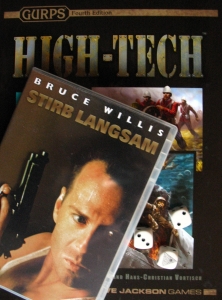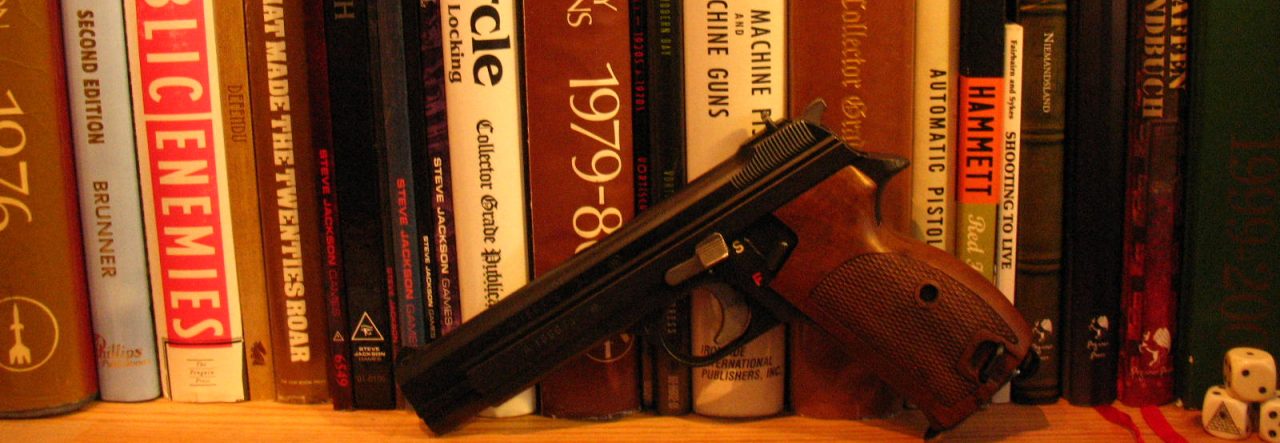This a practical review of one of my favourite pistols, the P7M8 made by Heckler & Koch of Oberndorf, Germany, with an eye towards its performance in games like GURPS, Call of Cthulhu, and Delta Green: The Role-Playing Game.
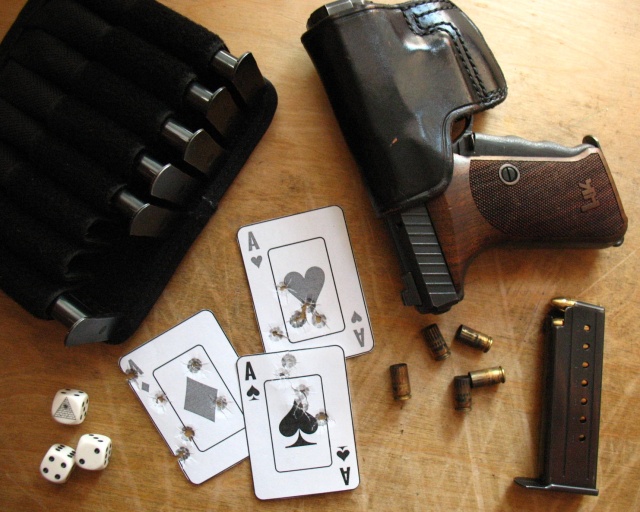
Describing the P7M8
The P7M8 is a single-action, single-stack, squeeze cocker semiautomatic in 9×19mm Parabellum. Originally designed by Helmut Weldle in 1978 as the Polizei-Selbstladepistole (“police self-loading pistol”) or PSP, it was adopted by several German police forces as the Pistole 7 or P7 ‒ ie, the seventh pistol to be introduced under the official German classification system used at the time, between the SIG-Sauer P6 and H&K P8. The P7M8 in turn was developed from 1981 and entered production in 1983, after it had been ordered by the New Jersey State Police. The P7M8 offers two major improvements over the P7, namely the ambidextrous magazine release behind the trigger ‒ rather than in the heel of the grip ‒ and the plastic heat shield under the gas piston.
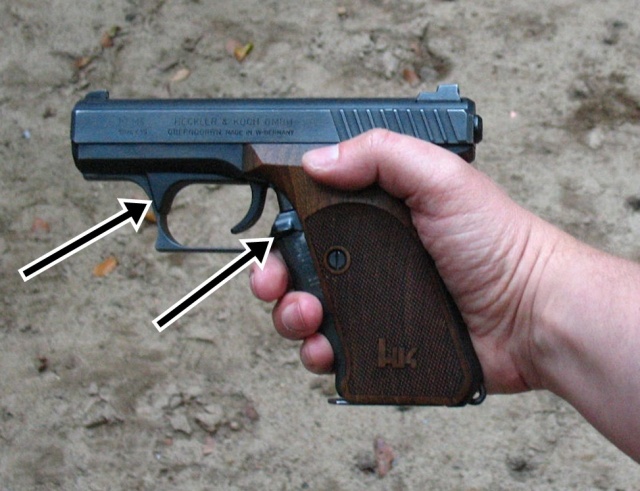
The P7-series has a gas piston below the barrel; this does not actuate the action, but merely delays the action’s backwards movement until the pressure has reached a safe level. This clever design allows for a simple blowback action despite the comparatively powerful 9×19mm Parabellum cartridge it fires. However, it also necessitates the heat shield, since the piston heats up the area below the barrel. The pistol quickly gets rather warm, and down-right hot after 50 shots or so fired in quick succession. Eventually, it becomes too hot to hold. This is not an issue in actual police service, for which it was designed, but can be a nuisance during intensive training.
The P7M8 is a short, sleek pistol with no protruding controls other than the ambidextrous magazine release. The safety lies in the squeeze cocker. By squeezing in the contoured bar in the front edge of the grip, the firing pin is cocked; by releasing it, the firing pin is uncocked and the weapon is safe again. Moreover, the squeeze cocker acts as a slide release. This improves reloading times; my reloads with the P7M8 are faster than with any other pistol. Once the slide locks open, eject the empty magazine ‒ either with your thumb or with the trigger finger; the latter is faster for me ‒, insert a fresh magazine, and tighten your grip thereby closing the slide and cocking the firing pin again. This is faster than hitting a slide release or retracting the slide, as is necessary with most other designs. Of course, you should normally reload before you’re empty, but this is not always feasible with a low-capacity pistol like this. Unlike with many other pistols, the magazines always fall free; the magazine ejection is so positive that it almost works with the pistol upside down!
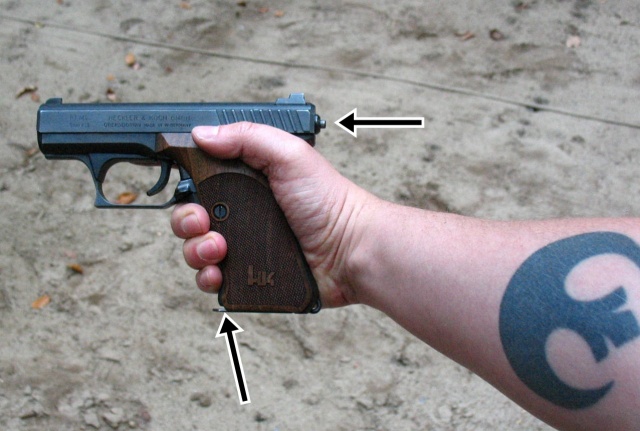
Despite its short overall length of 171 mm (6.73”), the P7M8 still boasts a 105 mm (4.13”) fixed barrel. Together with a low sightline, decent 3-dot sights, and a single-action trigger, this allows for good practical accuracy. The trigger is slightly mushy and thus could be better, but this is not a target pistol. Consistently good results can be achieved, limited mainly by the short sightline. The low bore axis over the hand transfers the recoil forces directly into the arm, which allows quick recovery between shots. At 7 m (7.7 yards) ‒ a typical distance both in IPSC matches and self-defence situations such as those mimicked by the 21 Foot Tueller Drill ‒ it is easy to place five factory-loaded 8-g (124-gr) Seller & Belliot bullets into a playing card even if shooting relatively fast. Good shooters drill five shots into one ragged hole at that distance. Putting five shots into an NRA B-3 50 Foot Rapid Pistol target at 15 m (16.4 yards) is also no problem.
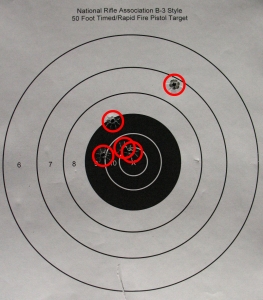
For a pistol of its size and capacity, the P7M8 is fairly heavy ‒ it tips the scales at 950 g (2.09 lbs) loaded. The very sturdy magazines weigh 165 g (0.36 lb) filled.
The P7M8 is extremely reliable; I cannot recollect a single malfunction after firing close to 10,000 shots. The original P7 has been reported to be picky with contemporary hollow-points, but more modern HP designs should not pose that problem. Due to the fluted chamber, the pistol has very positive ejection, throwing the cases half a dozen metres to the right. The cases can easily be identified by the lengthwise striations.
The P7M8 and its magazines are easy to field-strip for cleaning, requiring no tools.
H&K manufactured over 50,000 P7M8s between 1983 and 2007. The one depicted dates from 1991. It still shows no sign of wear except for the finish on the edges. It has been fitted with pair of textured walnut grips by Karl Nill of Mössingen, Germany.
Suitable gear for the P7M8 it includes an open JIT Slide leather holster by Don Hume of Miami, Oklahoma, and an Ichiro Nagata 8-In-Line Single Stack nylon magazine holder by TUFF of Chula Vista, California, which holds eight magazines (64 rounds) yet requires little real estate on the belt. The holster is simple but does the job, and over six years has kept its shape well. The magazine holder is an excellent piece of kit.
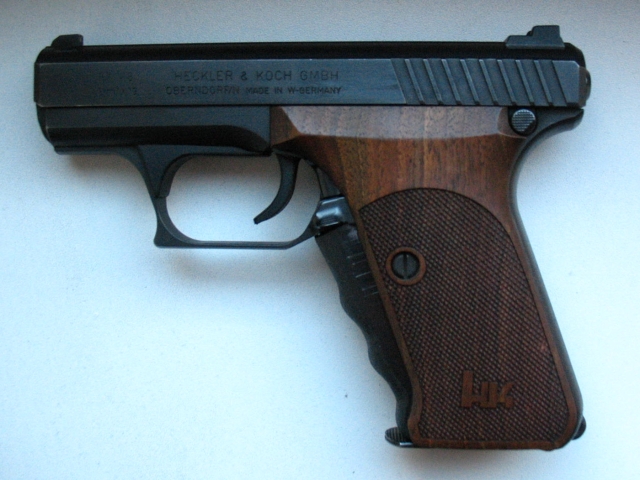
In Gaming
To date, I have covered the H&K P7M8 in several game books, including in GURPS Tactical Shooting (2011) (p. 56), Investigator Weapons 2: Modern Day (2014) (pp. 68-69), and the Cthulhu Waffenhandbuch (2008) (p. 93).
The P7M8 is a pistol that most people either love or hate. In GURPS, that might be a Weapon Bond (GURPS High-Tech, p. 250, and Tactical Shooting, p. 41). The GM should enforce the Familiarity rules (p. B169) due to the pistol’s unusual manual of operations, which requires practice to get used to. The slick reloading sequence might be grounds for a +1 bonus to Fast-Draw (Ammo) or to justify the Quick-Reload perk (Tactical Shooting, p. 39). Pressing and depressing the squeeze cocker emits an audible click. Not loud, but easily made out while approaching a target during the dead of night. This is made worse by the fact that users of the P7 tend to squeeze and release constantly, unlike with other designs that are cocked once and then stay that way. A number of special ops units have bemoaned this fact specifically. The GM could assign a +1 bonus to Hearing rolls or -1 penalty to Stealth rolls in appropriate situations.
In Call of Cthulhu, most of these issues fall under the radar, but the Keeper might assign a +5% bonus to Listen rolls or a -5% penalty to Sneak rolls.
In Delta Green, the P7M8 does not differ from other Medium Pistols except for its Ammo Capacity.
Firearmss Table
For an explanation of the statistics, see Delta Green: Agent’s Handbook, pp. 32, 54, 57, 60, 84.
| Weapon | Skill | Base Range | Damage | Lethality | Ammo Capacity | Armour Piercing | Expense |
| H&K P7M8, 9×19mm | Firearms | 15 m | 1D10 | N/A | 8 | N/A | Standard |
At the Picture Show
My favourite film scenes involving an H&K P7 pattern are, of course, in John McTiernan’s genre-defining Die Hard (1987), in which the double-stack P7M13 is used by über-sophisticated villain Hans Gruber (Alan Rickman).
